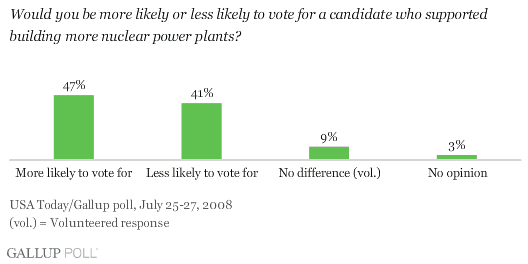Aug 29, 2008
PEAK LITHIUM? - THE DOWN SIDE TO LITHIUM BATTERIES
Goodbye 78,840,000 gallons of blue gold
HUGE - U.S. inks geothermal pact with two nations
Aug 28, 2008
A $60 billion grid problem, effective use of wind power on a wide scale is likely to remain a dream.
Why is this question not being asked?
Aug 16, 2008
Aug 15, 2008
Carbon sequestration WILL increase overall pollutants
Bush signs bill banning lead from children's toys
U.S. driving drop exceeds the 1970s' total decline
June 2008 saw another sharp drop in vehicle miles travelled (aka VMT) according to the Federal Highway Administration’s monthly report on “Traffic Volume Trends.”
Americans drove 4.7 percent less, or 12.2 billion miles fewer, in June 2008 than June 2007 — beating the record-setting drop of March (see here).
The moving 12-month trend-line is startling and again makes clear $4 a gallon is the first (but not the last) genuine tipping point for U.S. drivers:
Aug 11, 2008
Philips future is LED...
CLEAN HOME COULD GIVE CHILD ASTHMA
In the past, research has suggested that creating a clean home may stop a child being exposed to bacteria.
China's pollution goes global
Short sighted special interests
To paraphrase Senator John McCain... "It's not a question of whether or not we'll use the natural gas under Lake Erie. We're already doing that," Sonney said. "It's a question of whether we control our own destiny and harvest our own energy assets to our benefit or continue to leave energy resources in the hands of others."
WI Global Warming Task Force: all cost, no benefit
McGreenwashing
Dirty Jobs Mike Rowe going brown
Aug 10, 2008
A hundred billion dollars for Nuclear Power
The answer is perhaps as high as a hundred billion dollars.
Aug 8, 2008
Big bottled water still get FREE water from great lakes
If the compact passes in its present form, corporations will be exempt from adhering to the bill's most integral part: the ban on Great Lakes water exportation. Corporations like Nestle, Coca-Cola and Pepsi will still be able to draw off water and sell it for profit all over the country in a variety of products. David Dempsey reports
Going Nuclear? Yes, If You Are Looking To Get Elected
Because we look for easy answers and easily forget our past...
Even under the best peak uranium conditions Nuclear only buys a little time and will have no negligible payback within that lifetime. However, even minor mistakes in the nuclear energy field could have a infinite detrimental impact on our people and planet.
Nuclear energy questions the public needs answers for:
- How much viable uranium exists for the worlds demand (and what will be the cost)?
- How much debt is the nuclear industry in (and how heavy is it subsidized)?
- What is the current state of safety and environmental impact or our existing facilities and waste?
- How much does it cost to run, maintain and regulate this industry vs. net energy gains (after -yield costs)?
Four simple questions with hopeless answers under the current state.
Aug 6, 2008
Coal - Unstoppable future....
Yucca nuke waste now at $96.2 billion Wall Street Journal
Aug 5, 2008
Companies Agree To Cut Cancer-Causing Chemicals In Potato Chips
 "The companies agreed to reduce this carcinogenic chemical in fried potatoes -- a victory for public health and safety in California," said Attorney General Edmund G. Brown Jr. "Other companies should follow this lead and take steps to reduce acrylamide in french fries and potato chips."
"The companies agreed to reduce this carcinogenic chemical in fried potatoes -- a victory for public health and safety in California," said Attorney General Edmund G. Brown Jr. "Other companies should follow this lead and take steps to reduce acrylamide in french fries and potato chips."Aug 4, 2008
Al Gore Hope To Escape Dying Planet
 Young Gore sets out for his new home, where the sky is clear, the water is clean, and there are no Republicans.
Young Gore sets out for his new home, where the sky is clear, the water is clean, and there are no Republicans. EARTH—Former vice president Al Gore—who for the past three decades has unsuccessfully attempted to warn humanity of the coming destruction of our planet, only to be mocked and derided by the very people he has tried to save—launched his infant son into space Monday in the faint hope that his only child would reach the safety of another world.
"I tried to warn them, but the Elders of this planet would not listen," said Gore, who in 2000 was nearly banished to a featureless realm of nonexistence for promoting his unpopular message. "They called me foolish and laughed at my predictions. Yet even now, the Midwest is flooded, the ice caps are melting, and the cities are rocked with tremors, just as I foretold. Fools! Why didn't they heed me before it was too late?"
Al Gore—or, as he is known in his own language, Gore-Al—placed his son, Kal-Al, gently in the one-passenger rocket ship, his brow furrowed by the great weight he carried in preserving the sole survivor of humanity's hubristic folly.
"There is nothing left now but to ensure that my infant son does not meet the same fate as the rest of my doomed race,"
Read full From the onion
UK in 'delusion' over global emissions
The government has known about this for a very long time but has just refused to face up to it - Stuart Bond, WWF
